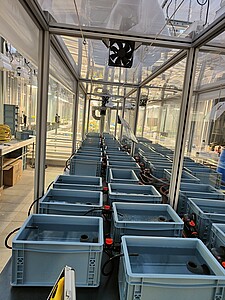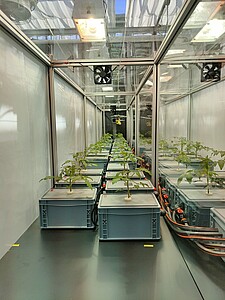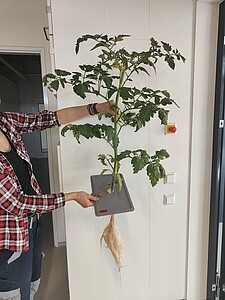Cleaning wastewater with hydroponic plant production
Theresa Detering
University of Hohenheim, Institute for Agricultural Sciences in the Tropics (Hans-Ruthenberg-Institute) (490)
Challenges
Relatively high nitrogen and phosphorus concentrations in wastewater have become an emerging concern worldwide because these elements cause eutrophication of natural surface waters and also nitrate percolating into groundwater poses a risk to human health. New treatment plants and their operation entail rising costs with increasing elimination requirements. Hence, approaches making use of waste water as an alternative water and nutrient source,while reducing potential contamination of the produce are urgently needed. The ability of vascular plants to take up nutrients efficiently from relatively low concentrated solution without significant yield reductions offers the possibility to couple hydroponic systems for crop production with wastewater treatment as an additional functional treatment step which effectively eliminates nitrogen and phosphorous. This bears the potential for highly efficient water and nutrient use, while unburdening natural waters.
In addition to genotypic characteristics of root architecture, the plants’ nutrient uptake ability depends on a variety of abiotic factors including ambient and water temperature, air humidity, light conditions, water electric conductivity and pH as well as imbalances in the composition of the nutrient solution. Therefore, nutrient uptake and its interactions with these factors need to be comprehensively understood to reap the double benefit of eliminating nutrients from wastewater and promoting crop production. This requires also a better understanding of the plants involved to balance nutrient solution depletion and vigorous plant growth across phenological stages.
In conventional hydroponics nutrient concentrations are kept prophylactically supra-optimal to avoid any deficiencies. Consequently, the available knowledge on hydroponic plant production at low nutrient concentrations is limited.
Objectives
The research objective is to investigate the nitrogen and phosphorous uptake ability of pilot plants from low concentrated nutrient solutions and the effect of environmental factors, either individually or in combination, on the uptake ability. The plants will include a specific variety of tomatoes, cucumber or bell pepper and alternative varieties or species. The environmental factors to be considered will be chosen by prioritisation of potential impact on the production on basis of literature data and information from the HypoWave and Hypowave+ project. The results should support identification of any yield limiting factors in the demonstration greenhouse of the HypoWave+ project
Expected results
The research will result in in-depth knowledge on nutrient uptake dynamics of different plant grown hydroponically in weakly concentrated nutrient solutions under varying environmental conditions. The results will be used to develop, test and ideally apply a model for species nutrient management of various species grown with wastewater. The research proposed here will create strong spill-over effects to other UHOH activities along similar research lines.
Aims
The final goal will be the application and evaluation of research results in a large-scale hydroponic system based on treated wastewater as sustainable innovation on resource-efficient agricultural water reuse.
With the project HypoWave+, the WPA research grant, and other following projects we will develop an even stronger competence and further contribute to food and water security and risk aversion in plant production.
Methods
The research proposed here will be complementary to the applied aspects in Hypowave+. A variety of abiotic factors influencing nutrient uptake and plant performance will be combined with artificially composed wastewater qualities and the effect on different plant species will be tested in greenhouse trials in Hohenheim. A special focus will be laid on weakly concentrated hydroponic solutions.
Abiotic factors that will be studied against nutrient dynamics in weakly concentrated nutrient solutions will be cascaded in a series of pot experiments. Transpiration is assumed to be a major determinant of nutrient uptake into plant tissue. Temperature in the root zone and ambient air temperature are known to influence nutrient dynamics in conventional systems (Thomson et al., 1998) and relative air humidity is known to influence transpiration (Nam et al., 2019). Therefore, different plant species (tomatoes and cucumber) and as alternatives to the main project e.g. lettuce, peas, or spinach) will be subjected to varying air humidity treatments. Nutrient uptake, nutrient depletion rate, plant growth and transpiration will be monitored with regular destructive samplings for nutrient uptake (autoanalyzer and flame photometry for Na and Ca) and biomass determination for plant growth. Regular samples from the nutrient solution allow assessing depletion of nutrients and regular weighing of the pots allows estimating transpiration. Using state-of-art gas exchange analyser (Walz GF 1300) allows monitoring transpiration and photosynthesis on leaf level for different development stages without destroying the plant. Ambient climatedata, EC, pH and temperature of the nutrient solution will be monitored in the greenhouses in Hohenheim.
The gained knowledge will then be integrateand in a model that helps to optimizing the water and nutrient management in hydroponic systems. The model will be parameterized with data in Hohenheim and in the second part of the proposed project the model will be validated and tested for the management of the greenhouse in Gifhorn




